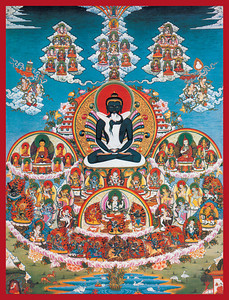
From The Spiritual Path: A Compilation of Teachings by Jetsunma Ahkon Lhamo
You do not see as the Buddha sees, with a mind that is natural, uncontrived, and relaxed. You do not know the natural state—your own Nature that is beneath the conceptualizations you force upon it. In essence you are the same as the Buddha. Why does He see Buddhas and Bodhisattvas without number, and you do not? Why is the Buddha’s mind free of action and reaction? The difference is one thing only: the concept of self to which you cling.
The concept of self is the effortful contrivance that results in all forms of suffering. Once your “self” is established, it is vulnerable to termination. It now has a beginning; therefore it will die. A tension arises. As a baby, you cried when you were hungry, and your mother probably responded. If she did not do so immediately, you sensed a threat to your survival. If you smiled and cooed, perhaps your mother paid more attention. You tried to protect the fabric of self. You began the long process of learning to attract, to have power over, other people. You developed tendencies to dominate, to be submissive, or to survive in other ways.
These habitual tendencies take time and effort to perfect. They become part of the fabric of our being. We call them our individuality and take pride in them. These subtle, habitual tendencies will stay with us over many lifetimes—unless they are somehow purified from the mindstream. In fact, the longer we accumulate assumptions about the self, the more deep-seated and complicated these subtle tendencies become. Ironically, those who pride themselves on their uniqueness and individuality are often in the most trouble. For even though the brain and the personality end at death, the karma remains. In fact, every moment of the perception of self has within it enough seeds for eons of cyclic existence. And these seeds have only to be watered by certain kinds of activity to ripen.
The original tightness or tension that accompanies the concept of “I-ness” is desire. This is why the Buddha taught that the basic cause for all suffering is desire. Some think that because they have learned not to desire a mate or a car or money or beauty, they have become true renunciates. They think they have overcome desire. They could not be further from the truth. Desire is simply too pervasive. It is what holds the concept of “I-ness” together. This concept becomes as invisible and familiar as the air we breathe. Everything we do supports and maintains our ego. It is only in the enlightened, realized state, with natural, uncontrived view, that activity is spontaneous, free of conceptualization, and therefore free of tension.
You, however, cling to your contrived thoughts, and the odd thing is—you love them. You are fascinated with the activity of your brain. You enjoy being opinionated. You love the excitement—so you think—of the tension that surrounds conceptualization. Every perception you have is made of tension born of desire.
Why is it so difficult to annihilate desire from your mindstream? You desire desire. Otherwise, you could snap your fingers and say, “I am through with it.” Why do you desire? Because you have so much investment, such a strong belief in your “I-ness” that your primary religion is not Buddhism but the preservation of your ego. That is your gut-level religion. You make offerings to it every moment. You take refuge in it every moment. The preservation of your ego and all the assumptions that go with it have been the love of your life, your soul mate.
How then can you even conceive of being free of desire, much less manage it? You may hear the teachings of the Buddha and want to be free, but another part of you is absolutely in love with yourself. And you love to be in love, so you are helpless. This is why the powerful Vajrayana path is so necessary and efficient. It would take extremely long to purify your mindstream by progressively renouncing every thought, every activity that increases desire, until you are basically doing nothing but watching your breath and annihilating every assumption and tension as it comes up in your mind. The Vajrayana path will do that, but it has another dimension: you purify your entire view. The five senses are purified through generation-stage practice. In it, you are not imagining a deity; you are not pretending it is there; you are not even visualizing. Certainly that may be where you start, but when it is done correctly and the skill of concentration is fully developed, you are actually disassembling and re-manufacturing the incorrect perceptions that permeate your every thought, word, and deed.
© Jetsunma Ahkön Lhamo











All living creatures get all their respect, animals too. That’s great.
Love for all creatures
http://www.hundefloete.de
WOW! May I disassemble and re-manufacture the incorrect perceptions that permeate my every thought, word, and deed in this very life and see as the Buddha sees!
Thanks for explaining Jetsunma!!! This is amazing!!!
Will you please give more direction how the five senses are purified through generation-stage practice? Thank you consistently posting!